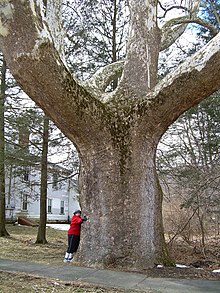| American sycamore | |
|---|---|

| |
| A 25 ft 8 in (8 m) girth tree in Sunderland, MA | |
| Scientific classification | |
| Kingdom: | Plantae |
| Clade: | Tracheophytes |
| Clade: | Angiosperms |
| Clade: | Eudicots |
| Order: | Proteales |
| Family: | Platanaceae |
| Genus: | Platanus |
| Species: | P. occidentalis
|
| Binomial name | |
| Platanus occidentalis | |

| |
| Generalized natural range of Platanus occidentalis | |
Platanus occidentalis, also known as American sycamore, American planetree, western plane,[2] occidental plane, buttonwood, and water beech,[3] is a species of Platanus native to the eastern and central United States, the mountains of northeastern Mexico, extreme southern Ontario,[4][5] and extreme southern Quebec.[6] It is usually called sycamore in North America, a name which can refer to other types of trees in other parts of the world; in the United Kingdom, for example, the name syacamore typically refers to Acer pseudoplatanus. The American sycamore is a long-lived species, typically surviving at least 200 years and likely as long as 500–600 years.[7]
The species epithet occidentalis is Latin for "western", referring to the Western Hemisphere, because at the time when it was named by Carl Linnaeus, the only other species in the genus was P. orientalis ("eastern"), native to the Eastern Hemisphere. Confusingly, in the United States, this species was first known in the Eastern United States, thus it is sometimes called eastern sycamore,[8][9] to distinguish it from Platanus racemosa which was discovered later in the Western United States and called western sycamore.
- ^ Stritch, L. (2018). "Platanus occidentalis". IUCN Red List of Threatened Species. 2018: e.T61956705A136056183. doi:10.2305/IUCN.UK.2018-2.RLTS.T61956705A136056183.en. Retrieved 19 November 2021.
- ^ "Platanus occidentalis". Trees and Shrubs Online. Retrieved 2019-12-03.
- ^ Alden, Harry A. (1994). "Fact Sheet for Platanus occidentalis". Center for Wood Anatomy Research. Retrieved 2019-12-03.
- ^ "Platanus occidentalis". County-level distribution map from the North American Plant Atlas (NAPA). Biota of North America Program (BONAP). 2014.
- ^ Sullivan, Janet (1994). "Platanus occidentalis". Fire Effects Information System (FEIS). US Department of Agriculture (USDA), Forest Service (USFS), Rocky Mountain Research Station, Fire Sciences Laboratory.
- ^ Gingras, Pierre. "Un nouvel arbre au Québec". La Presse.
- ^ "USDA Plant Guide: American Sycamore" (PDF). Retrieved 20 October 2022.
- ^ "Eastern Sycamore". Cornell Botanic Gardens.
- ^ "Platanus occidentalis - Plant Finder". Missouri Botanical Garden.
